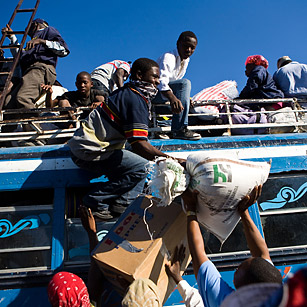
Faced with shortage of food, water, and lack of electricity, residents of Port-au-Prince, desperately try to board buses leaving the city.
Looking out the windows of his flight bridge high above the Navy aircraft carrier U.S.S. Carl Vinson, Rear Adm. Ted Branch watched large black H53 and smaller gray Seahawk helicopters lining up on his deck Friday afternoon. Rotors roaring, every chopper was set to hop the few miles to Port-au-Prince and deliver desperately needed relief supplies to the millions of victims of the earthquake that hit Haiti this week. Problem is, there still wasn't much else in the way of emergency aid to airlift back into Port-au-Prince by mid-afternoon, three days into the emergency. "We have a lot of lift out there," Branch says. "But not much relief supplies to offer."
When the carrier got word to head to Haiti hours after the massive Jan. 12 earthquake, it had hundreds of cases of water and Gatorade on board. The helicopters ferried those, along with some medical supplies, to the island nation soon after arriving offshore before dawn Friday. The Vinson also helped Medevac a U.S. citizen, who'd had his leg aputated after being crushed by a collapsed hotel in Port-au-Prince, to the ship's doctors.
Friday was the first real day of large-scale coordinated relief efforts for Port-au-Prince, where there is an initial estimate of 50,000 dead and millions more living without water, food, fuel and medical resources. It's the worst humanitarian disaster to ever hit the western hemisphere's poorest country, making quick delivery of relief supplies all the more urgent. But the helicopters and forklifts aboard the Vinson, the U.S.'s central relief platform since it arrived off Haiti's coast just before dawn Friday, are still waiting for an appreciable flow of aid they can carry across Port-au-Prince Bay, where the 3,000-man carrier is slowly circling. "The biggest challenge is getting the supplies here so we can get them out the population," says Branch. The campaign, he laments, "hasn't come as far it could have come at this point."
Before the Vinson's arrival, the lion's share of aid was being flown directly into the Port-au-Prince airport. But once there, its distribution to the city and countryside has been stymied in large part because the quake left so much of Haiti's ground transportation lanes all but impassable. As a result, the only really efficient way to convey it is via helicopter — and given the chaotic bottleneck that's developed at the airport, the aircraft carrier is a better launching pad for them.
The nuclear-powered Vinson had just come out of four years of drydock in Norfolk, Virginia, when the 7.0-magnitude temblor struck. En route to its new home port in San Diego, it was diverted to Haiti and moved at a rapid 32 knots for two and a half days, stopping only at Mayport, Fla., to pick up 15 additional large transport helicopters. Moving tons of bottled water, beans, blankets and plasma to a relief focal point like the Vinson doesn't happen overnight, of course. Still, now that the ship is off Port-au-Prince, it's unclear why the U.S. and other governments, as well as the U.N. and private aid agencies, didn't have more relief tonnage ready to move onto the Vinson from points like the U.S. naval base at Guantanamo, Cuba, just an hour's helicopter ride away.
More supplies are expected to land on the Vinson on Saturday. If the supply pace isn't significantly accelerated this weekend, officials fear, civil unrest could start to compound the suffering in Haiti. The Army's 82nd Airbone division is expected to assist in the supply delivery campaign to preserve order. But getting the Vinson helicopters loaded and dispatched is the best way to avoid disorder.
Friday morning, the carrier's officers, along with officials from the U.S. Agency for International Development (USAID), President Obama's lead agency on the Haitian relief effort, scanned aerial photographs of the country to determine the best, least affected spots to land the choppers. While they made about a dozen sorties into Port-au-Prince easily enough afterward, the mountainous terrain outside the capital made landing the larger H53 helicopters there more difficult as did the threat of their rotors stirring up hazardous earthquake debris on the ground and possibly causing the aircraft to crash. As a result, the smaller Seahawks, though they carry less, may have to be used to get help to rural areas.
The Vinson is also coordinating efforts with two Coast Guard cutters that arrived in the bay earlier. Three amphibious Navy ships are en route this weekend, and a Navy cruiser and two frigates are on standby. The Navy hospital ship Comfort is preparing at its port in Baltimore to come as well. Meanwhile, says Branch, the devastation onshore "is immense." So, he acknowledged, is the frustration of many aid workers who want to "get this process energized." And allow the admiral to use all the lift he's got at his disposal.